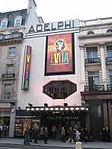Embassy of Zimbabwe in London
Buildings and structures in the City of WestminsterCharles Holden buildingsCovent GardenDiplomatic missions in LondonDiplomatic missions of Zimbabwe ... and 5 more
History of ZimbabweRhodesia–United Kingdom relationsUnited Kingdom–Zimbabwe relationsUse British English from May 2013Zimbabwe and the Commonwealth of Nations

The Embassy of Zimbabwe in London is the diplomatic mission of Zimbabwe in the United Kingdom. It is located in Zimbabwe House, a Grade II* Listed Building at 429 Strand in central London. It was previously a High Commission and became an embassy after Zimbabwe's departure from the Commonwealth on 7 December 2003 in protest of international criticism of Robert Mugabe's regime's human rights record and its policies.
Excerpt from the Wikipedia article Embassy of Zimbabwe in London (License: CC BY-SA 3.0, Authors, Images).Embassy of Zimbabwe in London
Strand, London Covent Garden
Geographical coordinates (GPS) Address External links Nearby Places Show on map
Geographical coordinates (GPS)
| Latitude | Longitude |
|---|---|
| N 51.5096 ° | E -0.124 ° |
Address
Embassy of Zimbabwe
Strand 429
WC2R 0JR London, Covent Garden
England, United Kingdom
Open on Google Maps






